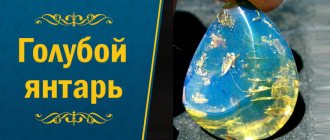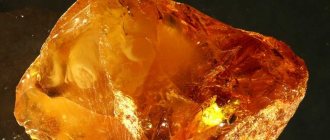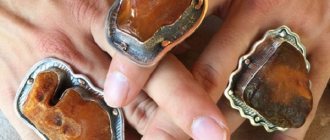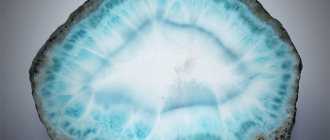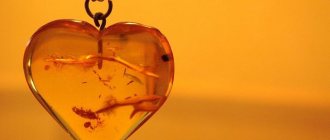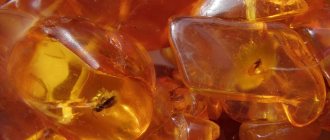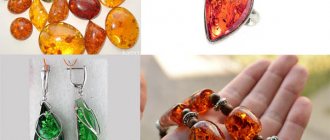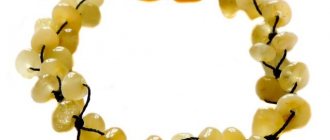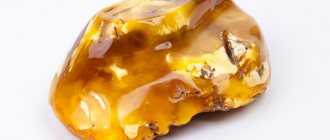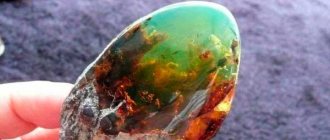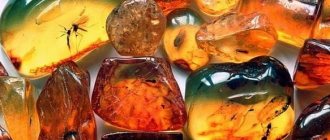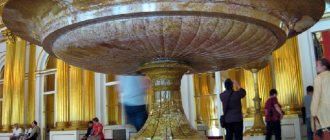Blue amber is one of the rarest varieties of this stone. Such specimens are mined only in one corner of our planet - in the Palo Quemado mine south of La Cumbre in the Dominican Republic.
It is noteworthy that blue amber is valued not only for its rarity and beautiful appearance. This is a special type of stone from this group, which is also distinguished by its pure transparency and a relatively large number of fossil inclusions - inclusions. Blue amber also has a special energetic power, which gives it healing and magical properties.
Origin of Sunstone
Origin of Sunstone
In reality, the stone has a yellow-blue hue. If you look at it under artificial light, it will be impossible to distinguish it from Baltic amber, and if you look at it under the sun's rays, it will emit a bright blue color.
The source of the rare stone is the carob tree, which existed millions of years ago in the Dominican Republic. Scientists assure that blue amber is at least 15 million years old.
In eastern Africa, the tree has an ancestor, Ceratonia, which produces a little resin that settles in the ground around it. Researchers studied this tree and found that most likely, a natural disaster occurred in the Dominican Republic more than 5 million years ago, as a result of which the entire flora and fauna suffered. The resin mixed with volcanic ash and eventually settled to the ocean floor. As a result of water pressure, the resin gradually changed and over time took the form of amber stones. After a new historical stage, the island rose to land and the gem became accessible. But it didn’t immediately arouse people’s interest.
FAQ
Where are the most blue amber deposits found?
Deposits of the precious stone were discovered in the Dominican Republic.
Characteristics of the mineral
Blue amber is a rare phenomenon, which is why its price is high. The annual volume of mined stone of different fractions is up to 400 kg. Compared to the total mass, these are modest numbers. The price of blue amber is several times higher than that of a product of a different color. For example, yellow specimens are much more common. They are mined in various parts of the world. Accordingly, such products cost much less.
Dominican stone is recognized by its unusually colored surface. Under the rays of light, blue amber comes to life, its colors begin to acquire more saturated shades and may change. If you look at the light, the mineral inside will glow yellow.
Various factors influence the formation of the color and structure of resin pieces in the ground. Dominican amber of blue or light blue color is not found everywhere. It is extracted only by a few mines (the largest of them is Palo Quemado), located south of La Cumbre. In this area, at a depth of 60-80 m, lie layers of gray clay, where rare-grade amber is found.
Some scientists deny any connection between the mineral and the soil. Amber became blue due to hydrocarbon impurities in it. It was this structural feature that gave the mineral its color and made it phosphorescent. Inside blue amber there are ancient life forms such as insects (scorpions), small animals, lizards and even frogs. The price of such a mineral is much higher. Sometimes there are inorganic inclusions - pyrite or sulfur.
Sunstone structure
The structure of a sunstone
Since the origin of the stone is associated with the aquatic environment, it is not surprising that the outlines of the remains of a living organism can be traced inside the mineral. Contains inside:
- particles of animal and plant life;
- seaweed;
- fish teeth
For some time, the resin retained a soft shape, which was attractive to marine fauna. Many scientists are excited about the idea of extracting DNA and breeding dinosaurs and other representatives of the prehistoric period.
An excerpt characterizing Mexican amber
“In my opinion,” Natasha suddenly almost screamed, turning her embittered face to Petya, “in my opinion, this is such disgusting, such an abomination, such... I don’t know!” Are we some kind of Germans?.. - Her throat trembled with convulsive sobs, and she, afraid to weaken and release the charge of her anger in vain, turned and quickly rushed up the stairs. Berg sat next to the Countess and comforted her with kindred respect. The Count, pipe in hand, was walking around the room when Natasha, with a face disfigured by anger, burst into the room like a storm and quickly walked up to her mother. - This is disgusting! This is an abomination! - she screamed. - It can’t be that you ordered. Berg and the Countess looked at her in bewilderment and fear. The Count stopped at the window, listening. - Mama, this is impossible; look what's in the yard! - she screamed. – They remain!.. – What’s wrong with you? Who are they? What do you want? - The wounded, that's who! This is impossible, mamma; this doesn’t look like anything... No, Mama, darling, this is not it, please forgive me, darling... Mama, what do we care about what we’re taking away, just look at what’s in the yard... Mama!.. This can’t be !.. The Count stood at the window and, without turning his face, listened to Natasha’s words. Suddenly he sniffed and brought his face closer to the window. The Countess looked at her daughter, saw her face ashamed of her mother, saw her excitement, understood why her husband was now not looking back at her, and looked around her with a confused look. - Oh, do as you want! Am I disturbing anyone? – she said, not yet suddenly giving up. - Mama, my dear, forgive me! But the countess pushed her daughter away and approached the count. “Mon cher, you do the right thing... I don’t know that,” she said, lowering her eyes guiltily. “Eggs... eggs teach a hen...” the count said through happy tears and hugged his wife, who was glad to hide her ashamed face on his chest. - Daddy, mummy! Can I make arrangements? Is it possible?.. – Natasha asked. “We’ll still take everything we need…” Natasha said. The Count nodded his head affirmatively at her, and Natasha, with the same quick run as she used to run into the burners, ran across the hall to the hallway and up the stairs to the courtyard. People gathered around Natasha and until then could not believe the strange order that she conveyed, until the count himself, in the name of his wife, confirmed the order that all carts should be given to the wounded, and chests should be taken to storerooms. Having understood the order, people happily and busily set about the new task. Now not only did it not seem strange to the servants, but, on the contrary, it seemed that it could not be otherwise, just as a quarter of an hour before it not only did not seem strange to anyone that they were leaving the wounded and taking things, but it seemed that it couldn't be otherwise. All the household, as if paying for the fact that they had not taken up this task earlier, busily began the new task of housing the wounded. The wounded crawled out of their rooms and surrounded the carts with joyful, pale faces. Rumors also spread in the neighboring houses that there were carts, and the wounded from other houses began to come to the Rostovs’ yard. Many of the wounded asked not to take off their things and just put them on top. But once the business of dumping things had begun, it could not stop. It didn't matter whether to leave everything or half. In the yard lay untidy chests with dishes, bronze, paintings, mirrors, which they had so carefully packed last night, and they kept looking for and finding an opportunity to put this and that and give away more and more carts. “You can still take four,” said the manager, “I’m giving away my cart, otherwise where will they go?” “Give me my dressing room,” said the countess. - Dunyasha will get into the carriage with me. They also gave away a wardrobe wagon and sent it two houses away to pick up the wounded. All the household and servants were cheerfully animated. Natasha was in an enthusiastically happy revival, which she had not experienced for a long time. -Where should I tie him? - people said, adjusting the chest to the narrow back of the carriage, - we must leave at least one cart. - What is he with? – Natasha asked. - With the count's books. - Leave it. Vasilich will clean it up. It is not necessary. The chaise was full of people; doubted about where Pyotr Ilyich would sit. - He's on the goat. Are you a jerk, Petya? – Natasha shouted. Sonya kept busy too; but the goal of her efforts was the opposite of Natasha’s goal. She put away those things that were supposed to remain; I wrote them down, at the countess’s request, and tried to take with me as many as possible. In the second hour, the four Rostov carriages, loaded and stowed, stood at the entrance. The carts with the wounded rolled out of the yard one after another. The carriage in which Prince Andrei was carried, passing by the porch, attracted the attention of Sonya, who, together with the girl, was arranging seats for the countess in her huge tall carriage, which stood at the entrance. – Whose stroller is this? – Sonya asked, leaning out of the carriage window. “Didn’t you know, young lady?” - answered the maid. - The prince is wounded: he spent the night with us and is also coming with us. - Who is this? What's the last name? – Our very former groom, Prince Bolkonsky! – sighing, answered the maid. - They say he is dying. Sonya jumped out of the carriage and ran to the Countess. The countess, already dressed for the trip, in a shawl and hat, tired, walked around the living room, waiting for her family in order to sit with the doors closed and pray before leaving. Natasha was not in the room. “Maman,” said Sonya, “Prince Andrei is here, wounded, near death.” He's coming with us.
History of amber
History of Amber
In the 10th century, Christopher Columbus mentioned his first encounter with the gemstone, which he encountered on the island of Hispaniola. The inhabitants of the island provided him with shoes, which had amber as decoration, but in return they demanded European beads. At that time, minerals were not of particular importance and the Spaniards were not interested in such an offer.
As a result of archaeological excavations, a huge number of other precious items were discovered:
- carved figures;
- pendants;
- rings;
- pendants.
Today, amber is considered a valuable stone not only in the Dominican Republic, but throughout the world.
Literature
- Dunlop, J. A., Harms, D., Penney, D., 2008, A fossil tarantula (Araneae: Theraphosidae) from Miocene Chiapas amber, Mexico: Revista Ibérica de Aracnología, 15, 9–17.
- Petrunkevitch, A. 1963. Chiapas amber spiders. Uni. Calif. Pubs. Entomol, 31: 1-40.
- Petrunkevitch, A. 1971. Chiapas amber spiders II. Uni. Calif. Pubs. Entomol., 63: 1-44.
- Petrunkevitch, A. el at. 1963. Studies of fossiliferous amber arthropods of Chiapas, Mexico. Uni. Calif. Pubs. Entomol. 31:1-60.
- Petrunkevitch, A. el al. 1971. Studies of fossiliferous amber arthropods of Chiapas, Mexico part II. Uni. Calif. Pubs. Entomol. 63:1-111.
- Poinar. G.O. Jr. 2001. Fossil puffballs (Gasteromycetes: Lycoperdales) in Mexican amber. Hist. Biol. 15: 119-122.
- Poinar. G.O. Jr. 2002. Fossil palm flowers in Dominican and Mexican amber. Hot. J. Linn. Soc., 138: 1-57.
- Ross, AJ, 2010, Amber, The Natural Time Capsule, 2nd Edition: London, UK, Natural History Museum. 112 p.
- Monica M. Solorzano Kraemer. (2010). Mexican Amber. pp.42—56, in: Penney, David (Ed.): [books.google.ru/books?id=YIb0_tXhT_4C&printsec=frontcover&hl=ru#v=onepage&q&f=false Biodiversity of Fossils in Amber from the Major World Deposits .] Manchester, Siri Scientific Press, 2010: 304 pp. ISBN 978-0-9558636-4-6
How and where they mine
How and where it is mined
For the first time, the mining of the mineral began in the middle of the last century, when gold products ceased to be as relevant as before. During the first years, the government of the Dominican Republic was at a loss and did not understand the European interest in mining and such huge exports.
At the end of the 70s, a law was introduced according to which the export of jewelry from the country by foreigners was prohibited. A few years later, the law was amended and it was prohibited to export amber in any form, including those that contained the remains of animals and plants. To do this, it was necessary to obtain special permission from the Natural History Museum.
The main mining of the mineral is carried out in the Palo Kemalo mine. To do this, use the simplest device:
- scoops;
- pickaxes;
- shovels.
Some even search for stones by hand. Collapses often occur in mines and many seekers die.
Jewelry Care
Blue amber, like regular amber, needs special care. Often, upon contact with oxygen, a series of small “webs” form on the surface of the stone. It looks as if it fell and began to crack internally. Such cracks can be polished (by cutting off 3 or 4 millimeters from the surface).
Blue stone
In addition, jewelry may darken with age. Old amber usually takes on a reddish hue. This is thought to be due to oxidation. But you shouldn’t be upset about this - darkening only increases the cost of the jewelry.
To slow down the aging of a stone, it is enough to regularly treat its surface with oil - it prevents the surface from oxidizing when exposed to air. Paradoxically, regularly wearing blue amber jewelry also prolongs their life. The natural oils of the leather will coat the jewelry and slow down the oxidation process, thereby continuing to please the owner for many years to come.
Video about Dominican amber - the most abundant one discovered in the eastern part of the island of Haiti (Caribbean Sea) in the Dominican Republic.
Application in jewelry production
Application in jewelry production
The unique characteristics, rarity and complex properties explain why the Dominican gemstone is considered the most expensive stone in the entire world. But unfortunately, in a year it turns out to extract 45-55 kg of mineral.
Compared to the 22 tons of diamonds mined annually, this amount of amber seems paltry. This also explains why the stone is present only in the most elite jewelry.
Amber is considered a fairly hard product, so only professional craftsmen can handle it. Every rich person in the world has this unique stone in his collection.
On a note! Residents of the Middle East value the mineral for its dark blue Misbahi prayer beads and it is used in expensive rosaries.
After undergoing processing, the jewelry exhibits its phosphorescent characteristics and a beige-blue glow appears.
The most unusual products can be viewed in one of the museums in Puerto Plata. Tourists will be able to:
- see unique stones with your own eyes;
- find out the history of their origin;
- look into the souvenir tent.
In specialized stores, amber jewelry will cost at least $500. You can find cheaper products in the markets, but there is a high probability of purchasing a fake. Raw amber can be purchased directly at the mining site. You can negotiate a deal with local residents and purchase a huge stone for $300-350.
Notes
- ↑ 1234
Monica M. Solorzano Kraemer. (2010). Mexican Amber. pp.42—56, in: Penney, David (Ed.): [books.google.ru/books?id=YIb0_tXhT_4C&printsec=frontcover&hl=ru#v=onepage&q&f=false Biodiversity of Fossils in Amber from the Major World Deposits .] Siri Scientific Press, 2010: 304 pp. ISBN 978-0-9558636-4-6 - George Poinar, Jr.
Amber // [books.google.co.uk/books?id=Jk0Hym1yF0cC&pg=PA475 Encyclopedia of Insects] / Vincent H. Resh & Ring T. Cardé. — 2nd. - Academic Press, 2009. - P. 8–11. — ISBN 9780123741448. - Wille, A. 1959. A new fossil stingless bee (Meliponini) from the amber of Chiapas, Mexico. J Paleontol 33: 849–852.
- Wygodzinsky, P. 1959. A new hemipteran (Dipsocoridae) from the Mexican amber of Chiapas, Mexico. Paleontol., 33: 853–854.
- Solorzano Kraemer, M. M. 2007. Systematic, palaeoecologv. and palaeobiogeography of the insect fauna from the Mexican amber. Palaeontogr. Abl. A, 282 1-133.
- Andrew J. Ross, Claire JT Mellish, Bill Crighton, Peter V. York. (2016). [boletinsgm.igeolcu.unam.mx/bsgm/vols/epoca04/6801/(7)Ross.pdf A catalog of the collections of Mexican amber at the Natural History Museum, London and National Museums Scotland, Edinburgh, UK]. Boletín de la Sociedad Geológica Mexicana. Volumen 68, no. 1, 2016, p. 45-55
- Riquelme F. et al. (2014). "Two Flat-Backed Polydesmidan Millipedes from the Miocene Chiapas-Amber Lagerstätte, Mexico." PLoS ONE 9
(8 e05877). DOI:10.1371/journal.pone.0105877. PMID 25162220. - Jennings John T., Lars Krogmann & Priya.
Hyptia deansi sp. nov., the first record of Evaniidae (Hymenoptera) from Mexican amber (English) // Zootaxa: Journal. - Auckland, New Zealand: Magnolia Press, 2012. - Vol. 3349. - P. 63–68. — ISSN [www.sigla.ru/table.jsp?f=8&t=3&v0=1175-5326&f=1003&t=1&v1=&f=4&t=2&v2=&f=21&t=3&v3=&f=1016&t=3&v4=&f=1016&t=3&v5 =&bf=4&b=&d=0&ys=&ye=&lng=&ft=&mt=&dt=&vol=&pt=&iss=&ps=&pe=&tr=&tro=&cc=UNION&i=1&v=tagged&s=0&ss=0&st=0&i18n=ru&rlf=&psz =20&bs=20&ce=hJfuypee8JzzufeGmImYYIpZKRJeeOeeWGJIZRrRRrdmtdeee88NJJJJpeeefTJ3peKJJ3UWWPtzzzzzzzzzzzzzzzzbzzvzzpy5zzjzzzzzzzzzzzzzzzzzzzzzzzzz zzzzztzzzzzzzbzzzzzzzzzzzzzzzzzzzzzzzzzzzzzzzzzyeyTjkDnyHzTuueKZePz9decyzzLzzzL*.c8.NzrGJJvufeeeeeJheeyzjeeeeJh*peeeeKJJJJJJJJJmjHvOJJJJJJJJfe eeieeeeSJJJJSJJJ3TeIJJJJ3..E.UEAcyhxD.eeeeeeuzzzLJJJJ5.e8JJJheeeeeeeeeeeeyeyeK3JJJJJJJJ*s7defeeeeeeeeeeeeeeeeeeeeeeeeSJJJJJJJZIJJzzz1..6LJJJJJJtJJZ4….EK*&deb ug=false 1175-5326]. - George Poinar Jr.
and Andrei A. Legalov. [palaeo-electronica.org/content/2016/1519-new-anthribidae-in-ambers New Anthribidae (Coleoptera: Curculionoidea) in Dominican and Mexican ambers] (English) // Palaeontologia Electronica: Journal. — 2016. — Vol. 19.2.24A. — P. 1-38.
How to recognize the original
How to recognize the original
Recently, new products called “Caribbean amber” have begun to appear on the jewelry markets. It has a transparent appearance with a greenish tint. Many believe that it has many similarities with blue amber, but only their mining was carried out on neighboring islands. But in fact, it was found that this is a high-quality fake that has undergone processing and artificially aged.
Question to the expert
What are the ways to distinguish high-quality jewelry from a fake?
Real amber should not sink in water and when heated it should have a pleasant smell.
To avoid becoming a victim of scammers, there are several proven ways to distinguish an original from a fake:
- place the stone in salt water - real amber will float to the surface, and the fake will lie at the bottom;
- the mineral has electrical properties. If you rub it and hold it near your hair for the first half a minute, it will begin to become electrified. If after rubbing the stone becomes sticky, then most likely you are holding a replica;
- When heated, the gemstone will emit a pleasant aroma. The fake will smell like smoky pine.
Tears of the Daughters of the Sun
One of the myths that arose in Ancient Greece tells about the reckless son of the god Helios - Phaethon. The young god, who died as a result of inept control of the solar chariot, was swallowed up by the waters of the Eridanus River. His sisters, the daughters of Helios, out of grief turned into trees on the banks of this river to mourn their brother who had left them. The tears of the Heliades - the daughters of Helios - fell into the water of Eridanus and froze there in transparent golden drops.
Scientists of all times have gone through many versions about the origin of amber. It was declared to be frozen sea foam or the contents of the stomachs of whales, because very often pieces of fragrant ambergris were washed ashore by the sea. But then they found the same stones in the mountains and decided that this special substance was mountain oil squeezed out of the stones by giants. Some were inclined to believe that it was simply honey that had become very hardened over time, and later petrified oil.
The true nature of the stone was discovered quite recently, and it turned out that the inhabitants of Hellas were right in their own way when they told legends about trees crying tears of sunlight. Precious amber turned out to be tree resin that had lain in the depths of the Earth for millions of years. And this is precisely what explains the findings of an amazingly beautiful gem in the Siberian taiga, and on the Caribbean islands, and on the coast of the Baltic Sea, and even in Africa, from where the precious electron was once transported to Ancient Greece and the Roman Empire.
Properties of blue amber
Properties of blue amber
Yellow amber is endowed with solar energy, and blue amber is endowed with air energy. Many peoples endow the mineral with magical properties:
- allows you to maintain peace of mind;
- promotes luck and fortune;
- clarity of mind appears;
- dispels negative energy;
- reveals wisdom in a person.
In the Middle Ages, residents were confident that amber had healing properties and was often used for diseases such as gout, asthma and the black plague.
Astrologers claim that blue amber is considered a symbol of the Cancer zodiac sign, as it accumulates the energy of the sunniest air sign. It also goes well with representatives of the water and air elements.
On a note! Amber can be used as decoration. It is often used to make pendants and earrings. This has a beneficial effect on the emotional and spiritual state of the owner.
The one and only
There is still debate about when the most mysterious of the amber family was formed. Some scientists claim that its age reaches 40 million years, others insist on the mark of 23-30 million years, and still others settle on 15-20 million.
Raw blue amber. Photo: dominicanblueamberwholesale.com
The blue variety of amber is mined in only one mine - Palo Quemado mine. It is located on the island of Haiti, which is washed by the Caribbean Sea. They do this by hand - first they cut small shafts, and then carefully extract the petrified resin from them. But this is not the only factor that makes blue amber exceptional compared to other varieties.
Is this stone really in demand?
The Kaliningrad Amber Plant, controlled by Rostec and developing an amber deposit in the Kaliningrad region, is one of the largest participants in the amber market. It accounts for 65% of the extraction and industrial processing of amber, which enters the world market. In 2022, the plant produced a record 525 tons of mineral. This year the company intends to maintain production at the same level. The extraction of yellow stone is largely determined by demand. And he is just growing.
According to Mikhail Zatsepin, General Director of Kaliningrad Amber Combine JSC, small fractions of amber are especially popular at the moment. This is due to the fact that many jewelry manufacturers have learned to “process it into jewelry and souvenir products.” In this regard, for the first time in several years, the plant’s warehouses were 70% empty, Interfax reports.
According to TASS, the Kaliningrad plant sells 69% of its products on the regional domestic market. About 22% of raw materials are supplied to other regions of Russia, and the rest of the products are exported to Belarus, China, France, Japan, Spain, Italy, and Germany.
It is also worth considering that processing of raw materials creates added value in the price of finished amber products.
This, in turn, contributes to an increase in demand for amber raw materials. The processed stones are then used by jewelers, as well as in furniture production, production of household and decorative products.
According to the Strategy for the Development of the Amber Industry of the Russian Federation until 2025, the total capacity of the world market for jewelry products with amber and other products processed from this fossil resin was estimated at 1.74 billion US dollars in 2014, with the greatest demand for these goods in India, China, and Japan and member states of the European Union.
